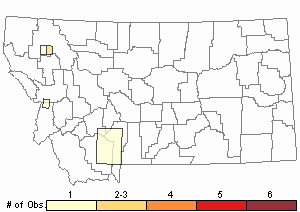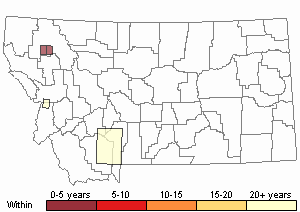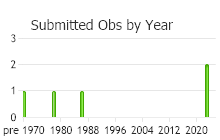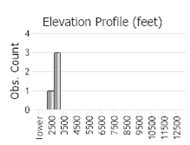View in other NatureServe Network Field Guides
NatureServe
Montana
Utah
Wyoming
Idaho
Wisconsin
British Columbia
South Carolina
Yukon
California
New York
Crystalwort - Riccia fluitans
General Description
The specific epithet, fluitans, is Latin for “floating” (Bland 1971)
Thalli pale to deep or bluish green, forked repeatedly with individual branches narrow, usually 2-4 mm in width or less and about 2.5 to 5 cm in length (Bland 1971, Schofield 2002). When dry, thalli paper-thin, and pale to deep green. Thalli composed mostly of air chambers, which bestow a translucent look, with pores absent (Schofield 1985). Rhizoids absent in aquatic form, only developing when plants are stranded by receding waters onto soil (Bland 1971), then appearing as fine white hairs. Branches of the terrestrial form may grow about twice as wide as those of the aquatic form, and display a shallow groove on their dorsal side (Nicholson 1966).
Diagnostic Characteristics
R. fluitan’s small thalli and embedded sporangia distinguish it from Riccardia species. Ricciocarpos species are larger in size and possess ventral scales, lacking in R. fluitans (Schofield 2002).
The genus Riccia differs from other genera with its combination of male and female reproductive structures, the spores eventually all embedded in the upper thallus tissue, and a sporophyte made only of a capsule (no seta or foot) without elaters (Doyle 2006).
Observations in Montana Natural Heritage Program Database
Number of Observations: 9
(Click on the following maps and charts to see full sized version)
Map Help and Descriptions
Relative Density

Recency



 (Observations spanning multiple months or years are excluded from time charts)
(Observations spanning multiple months or years are excluded from time charts)
Habitat
Shallow or quiet water of ponds, swamps, ditches, and slow-moving streams, often in pools with moderate amounts of dissolved minerals (Bland 1971, Nicholson 1966, Schofield 2002).
Ecology
R. fluitans floats in masses just under the water’s surface (Schofield 1985, 2002), its ribbony branches often interwoven with mosses, sometimes creating tangled mats (Bland 1971). Spore production is encouraged when the plants are stranded on soil. By keeping sporophytes within the dead thallus tissue until sufficient decomposition occurs, a trait the genus displays, the sporophytes are better protected in habitats that may experience extended periods of dryness (Schofield 1985).
Different Riccia species are often found growing together (Doyle 2006).
Reproductive Characteristics
The antheridia are affixed in thallus tissue (Schofield 1985), never in a specialized receptacle (Doyle 2006). Archegonia, leading ultimately to the sporophytes, are likewise embedded in the thallus. Upon decomposition of the thallus, sporophytes (each only composed of a capsule – no seta) (Doyle 2006) along with their spores are exposed. Sporophytes often develop in spring (Schofield 2002).
Management
Indole-3-acetic acid, a plant hormone of which 2, 4 –D is an analog, stimulates development of archegonia in the genus Riccia. (In some mosses, IAA encourages male-ness.) (Schofield 1985).
Stewardship Responsibility
References
- Literature Cited AboveLegend:
 View Online Publication
View Online Publication Bland, J.H. 1971. Forests of Lilliput: The Realm of Mosses and Lichens. Englewood Cliffs, NJ: Prentice-Hall. 210 p.
Bland, J.H. 1971. Forests of Lilliput: The Realm of Mosses and Lichens. Englewood Cliffs, NJ: Prentice-Hall. 210 p. Doyle, W.T. and R.E. Stotler. 2006. Contributions Toward a Bryoflora of California III. Keys and Annotated Species Catalogue for Liverworts and Hornworts. Madroño 53(2): 89-197.
Doyle, W.T. and R.E. Stotler. 2006. Contributions Toward a Bryoflora of California III. Keys and Annotated Species Catalogue for Liverworts and Hornworts. Madroño 53(2): 89-197. Nicholson, B.E. and F.H. Brightman. 1966. The Oxford Book of Flowerless Plants: Ferns, Fungi, Mosses and Liverworts, Lichens, and Seaweeds. London: Oxford University Press. 208 p.
Nicholson, B.E. and F.H. Brightman. 1966. The Oxford Book of Flowerless Plants: Ferns, Fungi, Mosses and Liverworts, Lichens, and Seaweeds. London: Oxford University Press. 208 p. Schofield, W.B. 1985. Introduction to Bryology. Caldwell, NJ: Blackburn Press. 434 p.
Schofield, W.B. 1985. Introduction to Bryology. Caldwell, NJ: Blackburn Press. 434 p. Schofield, W.B., P. Drukker-Brammall, and M. Pacheco. 2002. Field Guide to Liverwort Genera of Pacific North America. Banff, AB: Global Forest Society in association with University of Washington Press. 228 p.
Schofield, W.B., P. Drukker-Brammall, and M. Pacheco. 2002. Field Guide to Liverwort Genera of Pacific North America. Banff, AB: Global Forest Society in association with University of Washington Press. 228 p.
- Additional ReferencesLegend:
 View Online Publication
View Online Publication
Do you know of a citation we're missing? Elliot, J. C. 1993. Second checklist of Montana mosses. Unpublished report. U.S. Forest Service, Region 1. Missoula, MT. 45 pp.
Elliot, J. C. 1993. Second checklist of Montana mosses. Unpublished report. U.S. Forest Service, Region 1. Missoula, MT. 45 pp.
- Web Search Engines for Articles on "Crystalwort"





